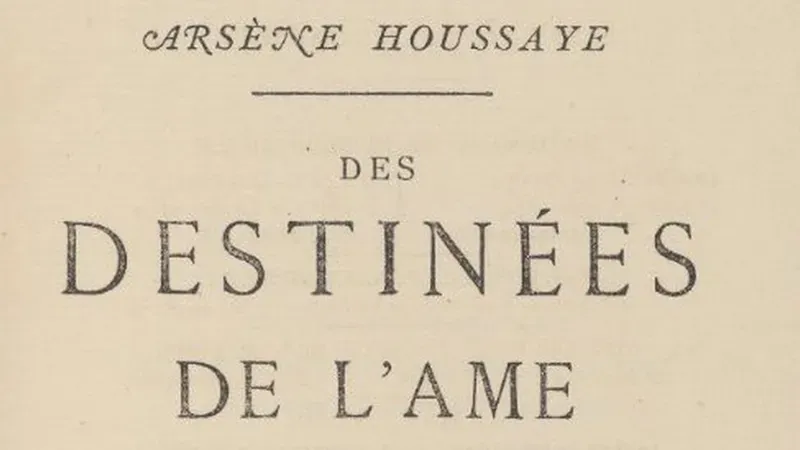Harvard removes human skin binding from book

From the BBC: "Des Destinées de l'Ame (Destinies of the Soul) has been housed at Houghton Library since the 1930s. In 2014, scientists determined that the material it was bound with was in fact human skin. But the university has now announced it has removed the binding "due to the ethically fraught nature of the book's origins and subsequent history". Des Destinées de l'Ame is a meditation on the soul and life after death, written by Arsène Houssaye in the mid-1880s. He is said to have given it to his friend, Dr Ludovic Bouland, a doctor, who then reportedly bound the book with skin from the body of an unclaimed female patient who had died of natural causes. Harvard said it was looking at ways to ensure "the human remains will be given a respectful disposition that seeks to restore dignity to the woman whose skin was used".
Plastic manufacturing companies deceived the public about recycling
From The Guardian: "Plastic producers have known for more than 30 years that recycling is not an economically or technically feasible plastic waste management solution. That has not stopped them from promoting it, according to a new report. “The companies lied,” said Richard Wiles, president of fossil-fuel accountability advocacy group the Center for Climate Integrity (CCI), which published the report. Plastic, which is made from oil and gas, is notoriously difficult to recycle. Doing so requires meticulous sorting, since most of the thousands of chemically distinct varieties of plastic cannot be recycled together. That renders an already pricey process even more expensive. The industry has known for decades about these existential challenges, but obscured that information in its marketing campaigns, the report shows."
In 1932 Australia started an Emu War and lost

From Atlas Obscura: "It sounds like a joke, but the Great Emu War of Western Australia was real. Soldiers with machine guns were deployed to fight off the flightless birds. What did the emus do to deserve armed combat? Western Australian farmers had been facing hard times with their crops following the Great Depression, and their difficulties increased tenfold with the arrival of some 20,000 emus migrating inland during their breeding season. The birds had been protected as a native species until 1922, but now that they were classified as “vermin,” all bets were off. The farmers relayed their concerns to the government, which called upon a deputation of ex-soldiers from the first World War, who requested the use of machine guns to fight off the emus."
Editor's note: If you like this newsletter, please share it with someone else. And if you really like it, perhaps you could subscribe, or contribute something via my Patreon. Thanks for being a reader!
The Easter Witches of Sweden

From JSTOR Daily: "In the sixteenth century, a fear of witches as agents of Satan arrived in Sweden. In witch hunts of the 1660s and 1670s, several thousand people were tried for allegedly making pacts with the devil. Hundreds were executed. In the mid-nineteenth century, Swedish Easter was many things: a sacred Christian holiday, a festive work-free day celebrated with pranks, and a time of real fear of witches. People lit bonfires and painted tar crosses on their barn doors to ward off evil. By that time, many people across western Sweden had also begun dressing up as witches at Easter. Teenagers and young adults donned worn clothes turned inside out. Cross-dressing was common: Boys might appear as old witches while girls could play the role of male Easter trolls."
When President Grover Cleveland suddenly disappeared for six days
From Almanac: "In 1893, during his second term as president, Grover Cleveland mysteriously disappeared from the public’s eye for nearly a week. He had been re-elected in 1892, the only president to leave the White House and return for a second term 4 years later. Immediately after taking office, he had to cope with a grave, national financial crisis. In the midst of this, Cleveland asked the White House physician to have a look at a “rough place” in the roof of his mouth. A tissue sample was immediately sent to the country’s top pathologist, and the word came back that it was malignant. The president took a train to New York, then a carriage from the train station to Battery Park at the tip of Manhattan. Lying offshore was Commodore Elias G. Benedict’s yacht Oneida, which the president boarded unseen and unsuspected."
Researchers found a unicorn cookbook at the British Library

From Medieval Manuscripts: "A long-lost medieval cookbook containing recipes for unicorns, has been discovered at the British Library. Experts believe that the cookbook was compiled by Geoffrey Fule, who worked in the kitchens of Philippa of Hainault, Queen of England (1328-1369). Geoffrey had a reputation for blending unusual flavours and everything points to his hand being behind the compilation. After recipes for herring, tripe and codswallop comes that beginning "Taketh one unicorne". The recipe calls for the beast to be marinaded in cloves and garlic, and then roasted on a griddle. The compiler added pictures in its margins, depicting the unicorn being prepared and then served."
Painting the Mona Lisa in 80 milliseconds
When Jamie Hyneman and Adam Savage built a one-of-a-kind, never-before-seen machine that demonstrated the difference between a GPU and CPU and painted the Mona Lisa in in 80 millisecondspic.twitter.com/F7rDsdN5CB
— Massimo (@Rainmaker1973) April 1, 2024
Acknowledgements: I find a lot of these links myself, but I also get some from other newsletters that I rely on as "serendipity engines," such as The Morning News from Rosecrans Baldwin and Andrew Womack, Jodi Ettenberg's Curious About Everything, Dan Lewis's Now I Know, Robert Cottrell and Caroline Crampton's The Browser, Clive Thompson's Linkfest, Noah Brier and Colin Nagy's Why Is This Interesting, Maria Popova's The Marginalian, Sheehan Quirke AKA The Cultural Tutor, the Smithsonian magazine, and JSTOR Daily. If you come across something interesting that you think should be included here, please feel free to email me.



